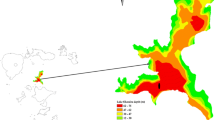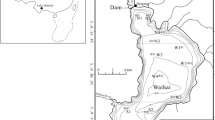Abstract
A reliable geochemical paleo-indicator for phosphorus remains elusive, despite the importance of understanding historical changes in the nutrient status of aquatic ecosystems. We assessed the potential of phytate (salts of myo-inositol hexakisphosphate) as a novel phosphorus-specific paleo-indicator by measuring its concentrations in dated sediments from an embayment in Helsinki, Finland, with a known 200-year history of trophic changes. Phytate was extracted in a solution containing sodium hydroxide and EDTA and detected by solution 31P NMR spectroscopy with spectral deconvolution. Concentrations varied markedly with sediment depth and paralleled previously determined changes in diatom assemblages and geochemical indicators linked to trophic status. In contrast, total sediment phosphorus did not reflect phosphorus inputs to the embayment, presumably due to the mobilization of inorganic phosphate under anoxic conditions during periods of high pollutant loading. Importantly, phytate appeared to be stable in these brackish sediments, in contrast to other organic and inorganic phosphates which declined abruptly with depth. We therefore conclude that phytate represents a potentially important indicator of historical changes in phosphorus inputs to water bodies, although additional studies are required to confirm its stability under conditions likely to be encountered in lakes and coastal ecosystems.




Similar content being viewed by others
References
Ahlgren J, Tranvik L, Gogoll A, Waldebäck M, Markides K, Rydin E (2005) Sediment depth attenuation of biogenic phosphorus compounds measured by 31P NMR. Environ Sci Technol 39:867–872. doi:10.1021/es049590h
Ahlgren J, Reitzel K, Tranvik L, Gogoll A, Rydin E (2006) Degradation of organic phosphorus compounds in anoxic Baltic Sea sediments: a 31P nuclear magnetic resonance study. Limnol Oceanogr 51:2341–2348
Anderson NJ (1997) Historical changes in epilimnetic phosphorus concentrations in six rural lakes in Northern Ireland. Freshw Biol 38:427–440. doi:10.1046/j.1365-2427.1997.00249.x
Anderson NJ (1998) Variability of diatom-inferred phosphorus profiles in a small lake basin and its implications for histories of lake eutrophication. J Paleolimnol 20:47–55. doi:10.1023/A:1007923813511
Anderson NJ, Rippey B (1994) Monitoring lake recovery from point-source eutrophication: the use of diatom-inferred epilimnetic total phosphorus and sediment chemistry. Freshw Biol 32:625–639. doi:10.1111/j.1365-2427.1994.tb01153.x
Andrén E, Shimmield G, Brand T (1999) Environmental changes of the last three centuries indicated by siliceous microfossil records from the southwestern Baltic Sea. Holocene 9:25–38. doi:10.1191/095968399676523977
Bennion H, Fluin J, Simpson GL (2004) Assessing eutrophication and reference conditions for Scottish freshwater lochs using subfossil diatoms. J Appl Ecol 41:124–138. doi:10.1111/j.1365-2664.2004.00874.x
Blomqvist S, Larsson U, Borg H (1992) Heavy metal decrease in the sediments of a Baltic Bay following tertiary sewage treatment. Mar Pollut Bull 24:258–266. doi:10.1016/0025-326X(92)90564-M
Bradshaw EG, Anderson NJ (2001) Validation of a diatom-phosphorus calibration set for Sweden. Freshw Biol 46:1035–1048. doi:10.1046/j.1365-2427.2001.00732.x
Cade-Menun BJ, Preston CM (1996) A comparison of soil extraction procedures for 31P NMR spectroscopy. Soil Sci 161:770–785. doi:10.1097/00010694-199611000-00006
Cade-Menun BJ, Benitez-Nelson CR, Pellechia P, Paytan A (2005) Refining 31P nuclear magnetic resonance spectroscopy for marine particulate samples: storage conditions and extraction recovery. Mar Chem 97:293–306. doi:10.1016/j.marchem.2005.05.005
Carman R, Edlund G, Damberg C (2000) Distribution of organic and inorganic phosphorus compounds in marine and lacustrine sediments: a 31P NMR study. Chem Geol 163:101–114. doi:10.1016/S0009-2541(99)00098-4
Cooper SR, Brush GS (1991) Long-term history of Chesapeake Bay anoxia. Science 254:992–996. doi:10.1126/science.254.5034.992
Cosgrove DJ (1973) Inositol polyphosphates in activated sludge. J Environ Qual 2:483–485
De Groot CJ, Golterman HL (1993) On the presence of organic phosphate in some Camargue sediments: evidence for the importance of phytate. Hydrobiologia 252:117–126
EDDI (2001) European Diatom Database. Newcastle University, UK, http://craticula.ncl.ac.uk/Eddi/jsp/datasets.jsp
Engstrom DR, Wright HE Jr (1985) Chemical stratigraphy of lake sediments as a record of environmental change. In: Haworth EY (ed) Lake sediments and environmental history. University of Leicester Press, Leicester, pp 11–67
Gardolinski PCFC, Worsfold PJ, McKelvie ID (2004) Seawater induced release and transformation of organic and inorganic phosphorus from river sediments. Water Res 38:688–692. doi:10.1016/j.watres.2003.10.048
Hall RI, Leavitt PR, Smol JP, Zirnhelt N (1997) Comparison of diatoms fossil pigments and historical records as measures of lake eutrophication. Freshw Biol 38:401–417. doi:10.1046/j.1365-2427.1997.00251.x
Harland BF, Oberleas D (1987) Phytate in foods. World Rev Nutr Diet 52:235–259
Hinedi ZR, Chang AC, Lee RWK (1989) Characterization of phosphorus in sludge extracts using phosphorus-31 nuclear magnetic resonance spectroscopy. J Environ Qual 18:323–329
Hupfer M, Gächter R, Rüegger H (1995) Polyphosphate in lake sediments: 31P NMR spectroscopy as a tool for its identification. Limnol Oceanogr 40:610–617
Hupfer M, Rube B, Schmieder P (2004) Origin and diagenesis of polyphosphate in lake sediments: a 31P-NMR study. Limnol Oceanogr 49:1–10
Jensen HS, Mortensen PB, Andersen FØ, Rasmussen E, Jensen A (1995) Phosphorus cycling in a coastal marine sediment, Aarhus Bay, Denmark. Limnol Oceanogr 5:908–917
Joung H, Juen BY, Li SJ, Kim J, Woodhouse LR, King JC et al (2007) Fecal phytate excretion varies with dietary phytate and age in women. J Am Coll Nutr 26:295–302
Korhola A, Blom T (1996) Marked early 20th century pollution and the subsequent recovery of Töölö Bay central Helsinki as indicated by subfossil diatom assemblage changes. Hydrobiologia 341:169–179. doi:10.1007/BF00018120
Mackereth FJH (1969) A short core sampler for subaqueous deposits. Limnol Oceanogr 14:145–151
Makarov MI, Haumaier L, Zech W (2002) Nature of soil organic phosphorus: an assessment of peak assignments in the diester region of 31P NMR spectra. Soil Biol Biochem 34:1467–1477. doi:10.1016/S0038-0717(02)00091-3
McKelvie ID (2007) Inositol phosphates in aquatic systems. In: Turner BL, Richardson AE, Mullaney EJ (eds) Inositol phosphates: linking agriculture and the environment. CAB International, Wallingford, pp 261–277
Smith MTE, Cade-Menun BJ, Tibbett M (2006) Soil phosphorus dynamics and phytoavailability from sewage sludge at different stages in a treatment stream. Biol Fertil Soils 42:186–197. doi:10.1007/s00374-005-0014-0
Sommers LE, Harris RF, Williams JDH, Armstrong DE, Syers JK (1972) Fractionation of organic phosphorus in lake sediments. Soil Sci Soc Am Proc 36:51–54
Suzumura M, Kamatani A (1993) Isolation and determination of inositol hexaphosphate in sediments from Tokyo Bay. Geochim Cosmochim Acta 57:2197–2202. doi:10.1016/0016-7037(93)90561-A
Suzumura M, Kamatani A (1995a) Mineralization of inositol hexaphosphate in aerobic and anaerobic marine-sediments—implications for the phosphorus cycle. Geochim Cosmochim Acta 59:1021–1026. doi:10.1016/0016-7037(95)00006-2
Suzumura M, Kamatani A (1995b) Origin and distribution of inositol hexaphosphate in estuarine and coastal sediments. Limnol Oceanogr 40:1254–1261
Tikkanen M, Korhola A, Seppä H, Virkanen J (1997) A long-term record of human impacts on an urban ecosystem in the sediments of Töölönlahti Bay in Helsinki Finland. Environ Conserv 24:326–337. doi:10.1017/S037689299700043X
Turner BL, Newman S (2005) Phosphorus cycling in wetlands: the importance of phosphate diesters. J Environ Qual 34:1921–1929. doi:10.2134/jeq2005.0060
Turner BL, Richardson AE (2004) Identification of scyllo-inositol phosphates in soils by solution phosphorus-31 nuclear magnetic resonance spectroscopy. Soil Sci Soc Am J 68:802–808
Turner BL, Papházy MJ, Haygarth PM, McKelvie ID (2002) Inositol phosphates in the environment. Philos Trans R Soc Lond Ser B 357:449–469. doi:10.1098/rstb.2001.0837
Turner BL, Mahieu N, Condron LM (2003a) Phosphorus-31 nuclear magnetic resonance spectral assignments of phosphorus compounds in soil NaOH–EDTA extracts. Soil Sci Soc Am J 67:497–510
Turner BL, Mahieu N, Condron LM (2003b) Quantification of myo-inositol hexakisphosphate in alkaline soil extracts by solution 31P NMR spectroscopy and spectral deconvolution. Soil Sci 168:469–478. doi:10.1097/00010694-200307000-00002
Turner BL, Mahieu N, Condron LM (2003c) The phosphorus composition of temperate pasture soils determined by NaOH–EDTA extraction and solution 31P NMR spectroscopy. Org Geochem 34:1199–1210. doi:10.1016/S0146-6380(03)00061-5
Turner BL, Cade-Menun BJ, Condron LM, Newman S (2005) Extraction of soil organic phosphorus. Talanta 66:294–306. doi:10.1016/j.talanta.2004.11.012
Turner BL, Newman S, Newman J (2006) Organic phosphorus sequestration in subtropical treatment wetlands. Environ Sci Technol 40:727–733. doi:10.1021/es0516256
Turner BL, Richardson AE, Mullaney EJ (eds) (2007) Inositol phosphates: linking agriculture and environment. CAB International, Wallingford
Vaalgamaa S (2004) The effect on urbanisation on Laajalahti Bay Helsinki City as reflected by sediment geochemistry. Mar Pollut Bull 48:650–662. doi:10.1016/j.marpolbul.2003.10.008
Watts EE, Dean PAW, Martin RR (2002) 31P nuclear magnetic resonance study of sediment microbial phospholipids. Can J Anal Sci Spectrosc 47:127–133
Weckström K (2006) Assessing recent eutrophication in coastal waters of the Gulf of Finland (Baltic Sea) using subfossil diatoms. J Paleolimnol 35:571–592. doi:10.1007/s10933-005-5264-1
Weimer WC, Armstrong DE (1979) Naturally occurring organic phosphorus compounds in aquatic plants. Environ Sci Technol 13:826–829. doi:10.1021/es60155a003
Wetzel RG (2001) Limnology. Lake and river ecosystems. Academic Press, San Diego
Acknowledgments
We thank Alex Blumenfeld (University of Idaho) and Paul Leeson (University of Helsinki) for analytical support, and S. Vaalgamaa and A. Korhola (University of Helsinki) for assistance in the field.
Author information
Authors and Affiliations
Corresponding author
Rights and permissions
About this article
Cite this article
Turner, B.L., Weckström, K. Phytate as a novel phosphorus-specific paleo-indicator in aquatic sediments. J Paleolimnol 42, 391–400 (2009). https://doi.org/10.1007/s10933-008-9283-6
Received:
Accepted:
Published:
Issue Date:
DOI: https://doi.org/10.1007/s10933-008-9283-6




